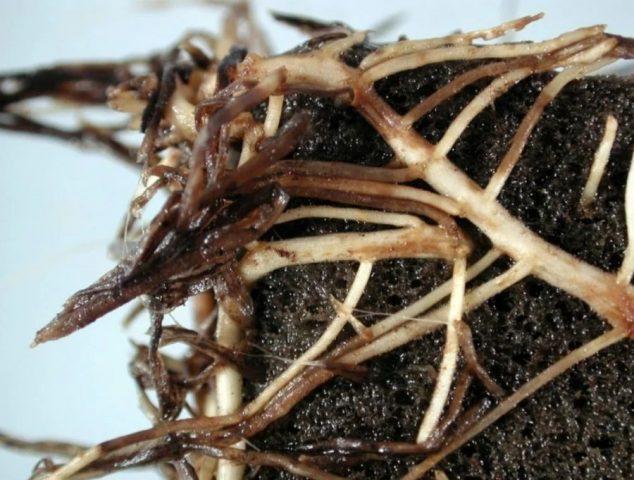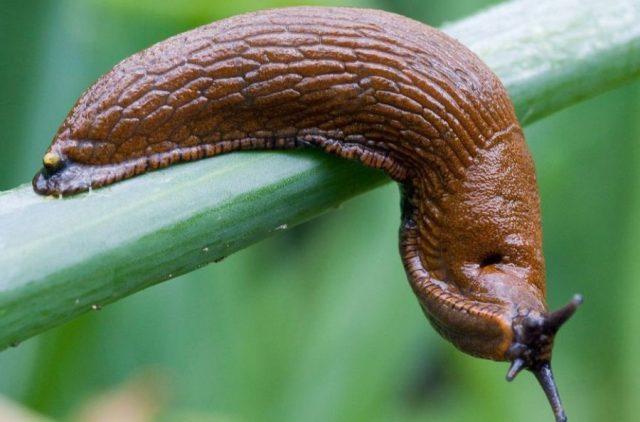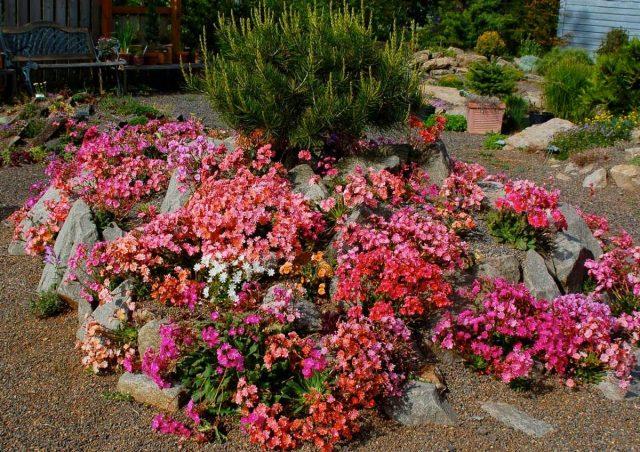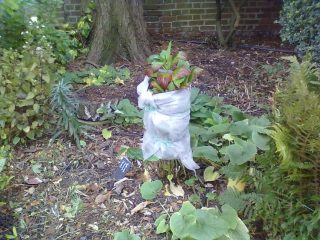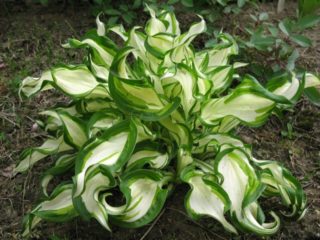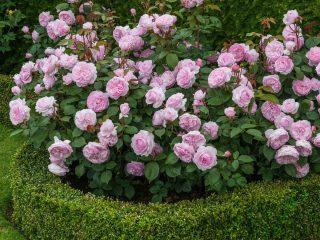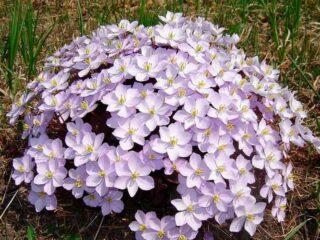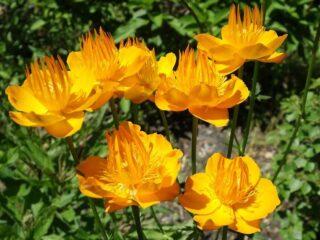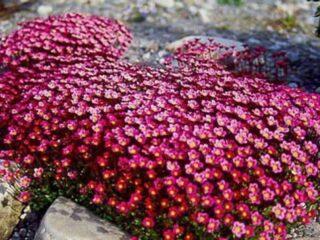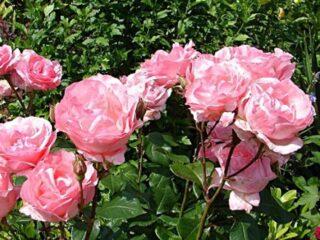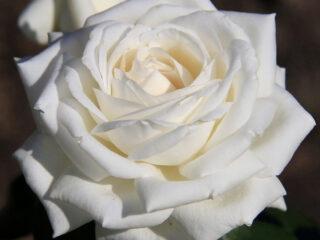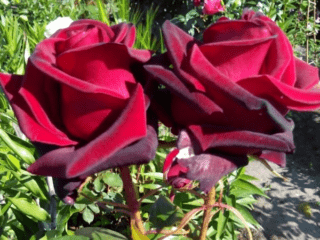Content
Photos and descriptions of the Levisia flower give an idea of an unpretentious perennial plant that can decorate a summer cottage. Before planting a crop, it is worth studying its features and requirements.
Description of Levisia
Levisia is a plant of the Montiaceae family, which has a developed root system consisting of numerous nodules. The aerial part is represented by a rosette of leaves up to 35 cm above the ground, the plates are oval or lanceolate, with a smooth edge and a leathery surface.
The flowering stem can stretch up to 20 cm; in mid-spring, small buds up to 2.5 cm in diameter bloom on the shoots. The petals of the perennial are narrow and elongated, with a pointed or torn tip. At the core of the corolla there are long stamens.Levisia can be yellow, pink or snow-white in color; there are red and lilac varieties of the plant.
In its natural form, the perennial grows in western North America. It is found at an altitude of 800-4000 m above sea level.
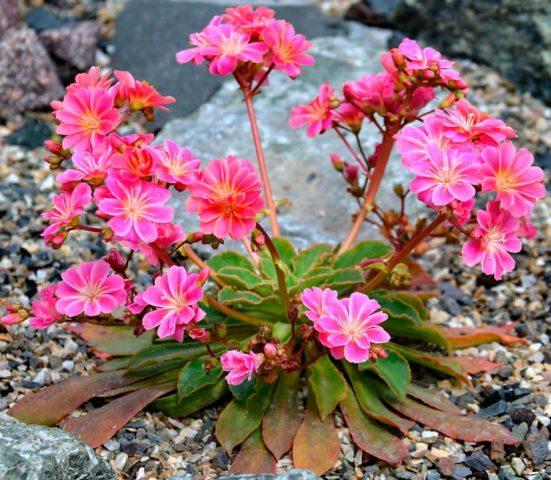
Levisia prefers to settle on dry or rocky soil
Levisia winter hardiness
Perennial Levisia has average frost resistance. With minimal shelter, the flower tolerates cold temperatures down to -30 °C.
Levisia flowering period
The flowering time of perennials depends on the variety. But most often the buds begin to bloom in May and June. The decorative period lasts about one and a half months, after which the perennial forms rounded dark brown or black seeds with a hole in the middle.
Levisia usually blooms once a year. But at the same time, some varieties produce buds twice during the season - in spring and early autumn.
Types and varieties of Levisia
Photos of the perennial Levisia flower show that the culture is represented by a large number of species. There are several of the most popular plants.
Levisia obtufolia (Cotyledon)
Levisia cotyledon (Lewisia cotyledon) is an evergreen plant with smooth, fleshy leaves. The plates reach 15 cm in length and have a wavy edge or a reddish border. The photo of the blunt-leaved Levisia shows that in spring or early summer the plant produces several flower stalks from the basal rosette, on which white, orange or reddish buds bloom.
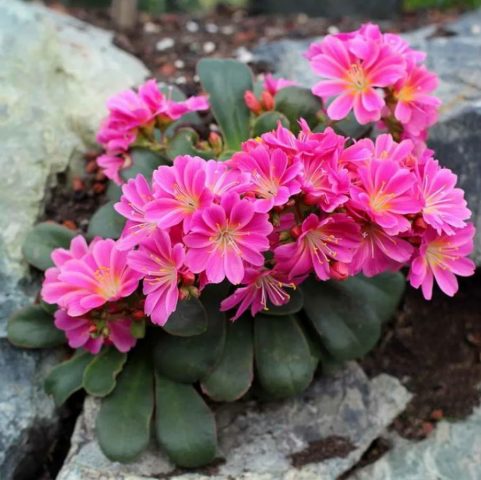
The flowering of Levisia obtufolia occurs in May and June.
Levisia long-petalled
Long-petalled lewisia (Lewisia longipetala) is a low succulent up to 20 cm above the ground. It bears buds at the end of May or June, and begins to bloom in the first year after planting.The petals of the plant can be pink, yellowish, red or purple.
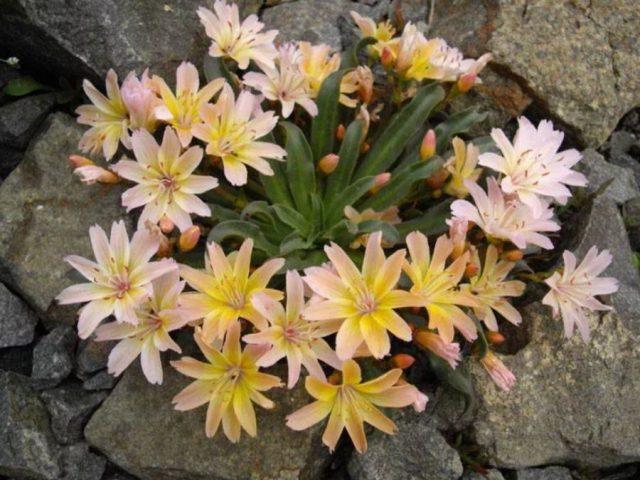
Long-petalled Levisia can withstand cold temperatures down to an average of -28 ° C
Levisia nevada
Nevada lewisia (Lewisia nevadensis) is a perennial plant that grows only 10 cm above the ground. The leaves of the crop are grooved, up to 15-20 cm in length, the buds are pinkish or white. The perennial prefers to grow on well-moistened clay or sandy soil.
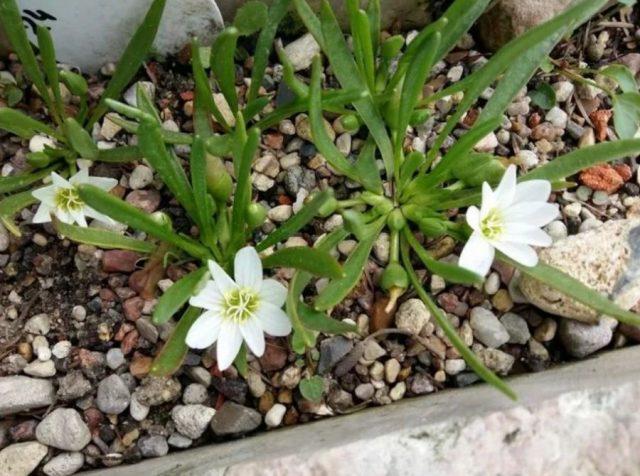
Nevada Levisia blooms late, in July and August.
Tweed
Tweed's lewisia (Lewisia tweedyi) is a miniature variety up to 15 cm above the ground. It blooms with creamy pink or whitish flowers with glossy silky petals. It develops well in partial shade and in natural conditions settles on rocky soil in gorges and on rocks.
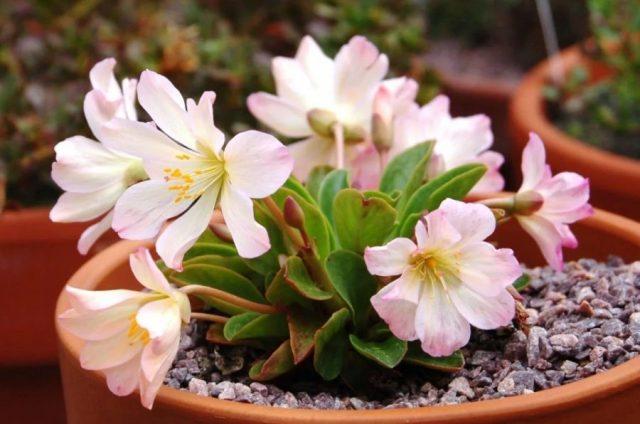
The diameter of the buds of Levisia Tweed reaches 5 cm
Colombian
Columbia lewisia (Lewisia columbiana) is a medium-sized perennial variety up to 30 cm tall. Blooms from May to August, bearing small flowers of pure white or pink with veins on the petals. You can meet the culture in its natural form in Oregon, British Columbia and Washington.
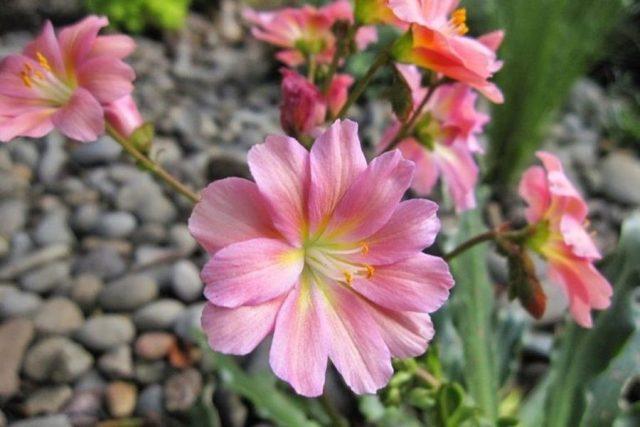
Columbia Levisia prefers rocky, light soils, but needs good moisture.
Updated
The updated lewisia (Lewisia rediviva) is one of the smallest, as it reaches only 5 cm above the ground. Blooms with pink or lilac buds with narrow, highly elongated petals. Dwarf Levisia flowers open only in warm sunny weather.
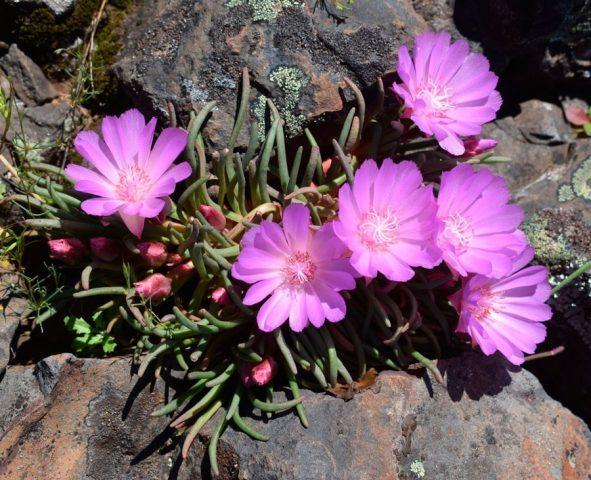
The roots of the renewed Levisia are suitable for human consumption.
Growing Levisia seedlings at home
Growing Levisia at home in a pot for subsequent transfer to the ground is quite simple. It is necessary to observe the optimal timing of sowing seeds, and then provide the seedlings with good care.
The planting procedure is usually carried out at the end of February or early March. For a perennial, select a shallow, wide container with drainage holes at the bottom and prepare a nutritious, loose substrate. It can be made from garden soil, peat and sand, taken in approximately equal proportions. Before use, both soil and containers are disinfected with boiling water or potassium permanganate to remove possible bacteria.
The algorithm for planting perennial seeds is as follows:
- The plant material is mixed with sand and placed in the refrigerator for three weeks.
- After stratification, the seeds are removed and pickled in a solution of potassium permanganate.
- Fill the seedling box with nutritious soil and water it thoroughly with lukewarm water.
- Spread the seeds on the surface of the soil.
- Sprinkle a thin layer of substrate on top.
- Spray the plantings generously from a spray bottle.
After this, the container is covered with film and placed in a warm, moderately lit place. After sprouts form, the polyethylene will need to be removed. The box is moved to the sunniest windowsill and the seedlings are grown until the final warmth is established at home. Care comes down mainly to watering; after 2-3 true leaves appear, you can also plant them in separate containers.
Growing Levisia in open ground
Levisia planting for care in open ground is usually done in early June. On the site for the culture, select a dry, well-lit place on the western or eastern side of the garden.It is best to place the perennial on a hillock or on a rocky wasteland. The plant needs plenty of light with light afternoon shading. It is also important to take care of the presence of drainage in the soil - the flower does not tolerate waterlogging.
Before planting Levisia for cultivation in open ground in the Moscow region, the soil is dug up properly and sand or gravel is added to it to increase looseness. It is also advisable to add minerals and humus to the soil. The immediate planting scheme for perennials looks like this:
- Several holes up to 50 cm deep are dug in the area.
- A thick layer of drainage is laid at the bottom of the holes.
- A loose substrate with the addition of sand and humus is poured on top.
- Plant the seedlings in the center of the holes.
- Sprinkle the voids with the remains of the substrate.
Immediately after planting, the perennial needs to be watered abundantly. It is also recommended to sprinkle the tree trunk circle with gravel, covering the root collars of the plants.
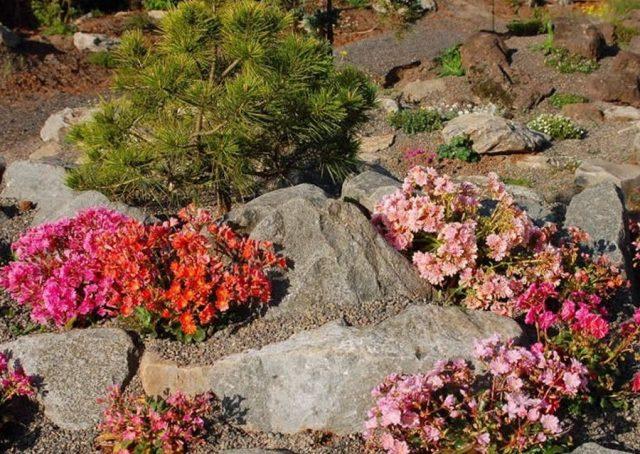
The optimal pH for Levisia is 5-7 units
Care instructions
When growing a perennial on a plot, you need to provide high-quality care. It comes down to a few basic procedures.
Watering
Levisia is a drought-resistant plant. It is necessary to moisten the perennial mainly after planting, so that it quickly takes root in the ground. In the future, watering is reduced to a minimum. Water is added only in severe drought and prolonged absence of precipitation.
Fertilizer
Fertilizing for perennials is carried out twice during the growing season. At the beginning of budding, the plant is fertilized with mullein solution for more abundant flowering. At the end of summer, superphosphate is added to the soil, which helps increase the endurance of the crop.
Trimming
The perennial does not need a full pruning, but during the flowering process it is recommended to remove drying buds. In addition, at the end of the decorative period, it is worth trimming or pinch off the wilted stems.
Wintering Levisia
With the onset of autumn, the plant in the open ground is covered with a thick layer of dry foliage. If the winter is expected to be cold, then you need to additionally cover the perennial with lutrasil or agrofibre. It is also allowed to cover the plant with spruce branches, which will protect the bushes from frost and wind.
During wintering, Levisia may suffer from waterlogging of the roots. To prevent this from happening, it is necessary to ventilate the perennial during the thaw period.
Reproduction of Levisia
Perennials can be propagated on a site using generative or vegetative methods. For rare varieties, cuttings are usually used; simple varieties are grown from seeds.
Cuttings
After the formation of daughter rosettes in an adult perennial, they are carefully separated with a sharpened knife and slightly dried on the cut. Then the cuttings are treated with a fungicidal preparation and a growth stimulator. After disinfection, the rosettes are planted in a loose substrate, moistened and covered with a cut glass bottle. When the cuttings begin to grow, they can be carefully transferred to a permanent place while preserving the earthen clod.
Seed propagation
Perennial seedlings are planted in early spring; the material is sown in loose soil in home containers. Until about the beginning of June, the seedlings are kept on a well-lit windowsill and watered regularly, and then transferred to the site.
It is also allowed to plant perennial seeds directly into the soil. The material is laid in the ground in October or November, the flowerbed is reliably insulated, and with the onset of spring, green shoots are obtained.There is no need to water the perennial during autumn planting; it may begin to grow prematurely and die.
Diseases and pests
If agricultural practices are followed, the perennial rarely suffers from fungi and insects. But in unfavorable conditions it can be affected by:
- root rot - the disease poses a great danger to drought-resistant perennials, the leaves become soft and flabby, covered with brown spots;
Root rot develops when the soil is overwatered and lacks drainage.
- slugs - mollusks feed on low plants in wet weather.
To protect against slugs, it is recommended to treat Levisia with an infusion of wood ash or metaldehyde preparations.
To prevent diseases, you need to carefully follow cultivation techniques. Particular attention is paid to the intensity of watering - the soil should not be swamped, it should only be slightly moist.
If symptoms of the fungus do appear on Levisia leaves, you must urgently remove severely damaged plants from the flowerbed. The remaining perennials are treated with copper preparations to prevent rotting, and, if necessary, transplanted to a drier area.
Application in landscape design
Most often, the plant is planted on the site on alpine hills or rockeries. The culture goes well with saxifrage and bells, gentian and cuff. You can place the perennial near conifers that have similar care requirements.
Levisia is used to decorate rocky wastelands in the garden.
Conclusion
Photos and descriptions of the Levisia flower give an idea of a low perennial with modest care requirements.The crop is suitable for planting on dry rocky soil and does not require abundant watering or frequent fertilizing.
Levisia reviews
